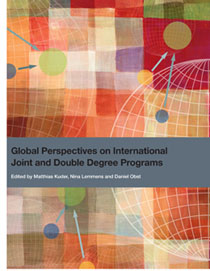
| IIE Home | Membership | Publications | Open Doors | Contact Us |
|
||
|
||
 Joint and double degree programs are an increasingly popular approach to internationalizing higher education. A new book published by the IIE and the German Academic Exchange Service (DAAD) brings together expert insight from 33 authors spanning six world regions for the first truly global analysis of collaborative degree programs and what they mean for students and higher education today. Joint and double degree programs are an increasingly popular approach to internationalizing higher education. A new book published by the IIE and the German Academic Exchange Service (DAAD) brings together expert insight from 33 authors spanning six world regions for the first truly global analysis of collaborative degree programs and what they mean for students and higher education today.
Global Perspectives on International Joint and Double Degree Programs, available now on IIEBooks.org, provides an orientation for higher education institutions, government agencies, and other related organizations as they develop their approaches and policies. Articles include:
About Global Perspectives on International Joint and Double Degree Programs:
While some institutions have characterized these international degree programs as too complex and too expensive to implement, analyses in the book show that—when done right—the benefits can outweigh the costs. Like many revolutionary ideas before, the pioneering joint and double degree programs were seen as avant-garde by some and completely impractical by others. Indeed, it took more than a decade since the early programs began in the 1990s, primarily in Europe, for a broader section of the international higher education community to come around to the idea and begin to initiate new collaborative degree programs at their own institutions.
Today, cross-border collaborative degree programs are continuing to gain traction around the world, because they offer opportunities for colleges and universities to build strong institutional partnerships and provide particularly deep and meaningful international experiences to students. Students are beginning to seek out the international competency currency that such collaborative degrees have to offer beyond the benefits of a degree from a single institution.
"As they seek new ways to prepare global citizens and perform cutting-edge research across borders, higher education institutions are increasingly looking to innovations like joint and double degree programs as a promising path into the future," says Allan Goodman, IIE’s President and CEO. Margret Wintermantel, President of the DAAD, commented that "Joint and double degree programs are an important contribution to the internationalization of higher education and to the strengthening of international exchange among students and academia. Since these programs open up new opportunities to develop strategic partnerships and networks between institutions of higher education worldwide, the number of projects has steadily increased within the last years,"
Colleges and universities can use these degree programs to broaden their educational offerings, strengthen research collaboration, advance internationalization, and raise the institution’s international visibility and prestige. In some cases, they might even result in increased revenue. On a global level, collaborative degrees provide a chance to build particularly strong strategic academic partnerships between higher education networks around the world, and they have become an increasingly important element of the educational exchange relationship between countries.
Global Perspectives on International Joint and Double Degree Programs is edited by Matthias Kuder of Freie Universität Berlin, Nina Lemmens of DAAD, and Daniel Obst of IIE. Obst and Kuder are co-authors of the IIE international survey report "Joint and Double Degree Programs in the Global Context" (2011). Global Perspectives on International Joint and Double Degree Programs is the first in a new "Global Perspectives" series of joint publications by IIE and DAAD that will explore pressing issues in international higher education.
A limited-time package deal includes the new book plus IIE’s 2011 publication Joint and Double Degree Programs: An Emerging Model for Transatlantic Exchange for $59.95 (an $80 value).
|
| www.iie.org/iienetwork • Member website of the Institute of International Education © 2025 Institute of International Education. All rights reserved. |



